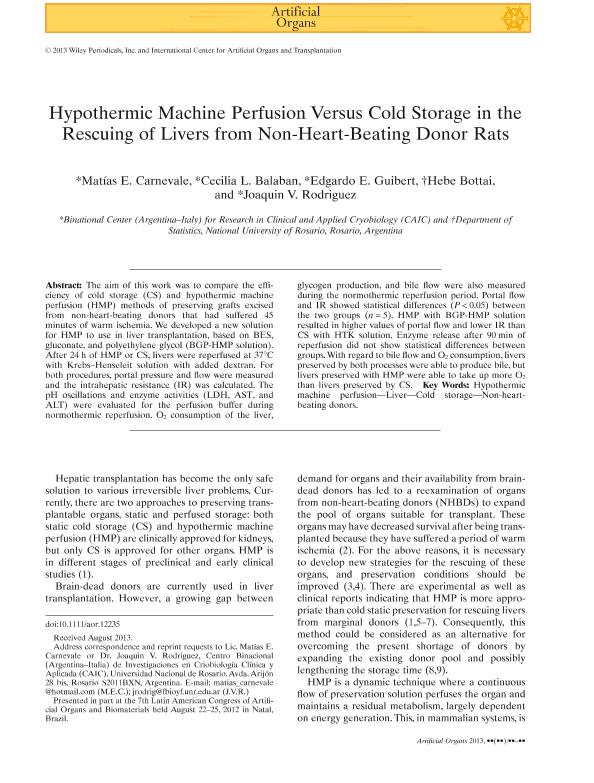Artículo
Hypothermic Machine Perfusion Versus Cold Storage in the Rescuing of Livers From Non-Heart-Beating Donor Rats
Carnevale, Matías Emanuel ; Balaban, Cecilia Lucía
; Balaban, Cecilia Lucía ; Guibert, Edgardo Elvio
; Guibert, Edgardo Elvio ; Bottai, Hebe; Rodriguez, Joaquin Valentin
; Bottai, Hebe; Rodriguez, Joaquin Valentin
 ; Balaban, Cecilia Lucía
; Balaban, Cecilia Lucía ; Guibert, Edgardo Elvio
; Guibert, Edgardo Elvio ; Bottai, Hebe; Rodriguez, Joaquin Valentin
; Bottai, Hebe; Rodriguez, Joaquin Valentin
Fecha de publicación:
11/2013
Editorial:
Wiley
Revista:
Artificial Organs
ISSN:
0160-564X
Idioma:
Inglés
Tipo de recurso:
Artículo publicado
Clasificación temática:
Resumen
The aim of this work was to compare the effi- ciency of cold storage (CS) and hypothermic machine perfusion (HMP) methods of preserving grafts excised from non-heart-beating donors that had suffered 45 minutes of warm ischemia. We developed a new solution for HMP to use in liver transplantation, based on BES, gluconate, and polyethylene glycol (BGP-HMP solution). After 24 h of HMP or CS, livers were reperfused at 37°C with Krebs–Henseleit solution with added dextran. For both procedures, portal pressure and flow were measured and the intrahepatic resistance (IR) was calculated. The pH oscillations and enzyme activities (LDH, AST, and ALT) were evaluated for the perfusion buffer during normothermic reperfusion. O2 consumption of the liver, glycogen production, and bile flow were also measured during the normothermic reperfusion period. Portal flow and IR showed statistical differences (P < 0.05) between the two groups (n = 5). HMP with BGP-HMP solution resulted in higher values of portal flow and lower IR than CS with HTK solution. Enzyme release after 90 min of reperfusion did not show statistical differences between groups. With regard to bile flow and O2 consumption, livers preserved by both processes were able to produce bile, but livers preserved with HMP were able to take up more O2 than livers preserved by CS.
Archivos asociados
Licencia
Identificadores
Colecciones
Articulos(CCT - ROSARIO)
Articulos de CTRO.CIENTIFICO TECNOL.CONICET - ROSARIO
Articulos de CTRO.CIENTIFICO TECNOL.CONICET - ROSARIO
Citación
Carnevale, Matías Emanuel; Balaban, Cecilia Lucía; Guibert, Edgardo Elvio; Bottai, Hebe; Rodriguez, Joaquin Valentin; Hypothermic Machine Perfusion Versus Cold Storage in the Rescuing of Livers From Non-Heart-Beating Donor Rats; Wiley; Artificial Organs; 37; 11; 11-2013; 985-991
Compartir
Altmétricas



